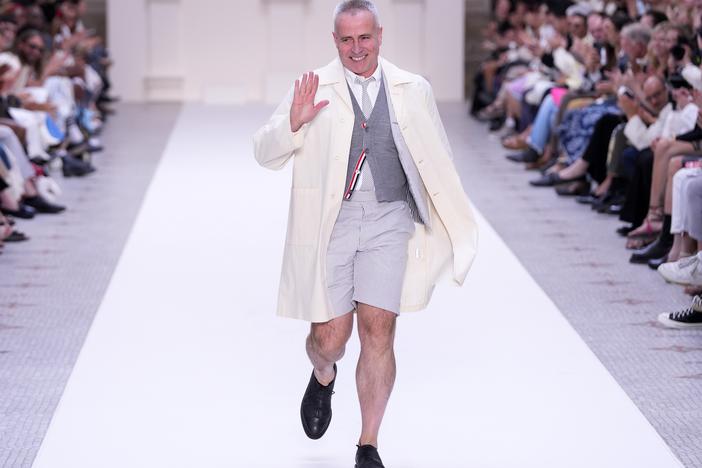Section Branding
Header Content
The 'Great Animal Orchestra' brings the wild rumpus of nature to art museums
Primary Content
An evocative museum exhibition from a legendary electronic musician and naturalist encourages audiences to connect with nature through a "great animal orchestra."
Transcript
STEVE INSKEEP, HOST:
And I'm Steve Inskeep with sounds of "The Great Animal Orchestra."
(SOUNDBITE OF BERNIE KRAUSE'S "THE GREAT ANIMAL ORCHESTRA")
INSKEEP: Hm, could keep that going for a while. Those are soundscapes of nature, from the flute sounds of birds to the harmonies of arctic wolves. "The Great Animal Orchestra" is an audio art exhibit that has traveled the world and is now at the Peabody Essex Museum in Salem, Mass., where NPR's Neda Ulaby paid a visit.
NEDA ULABY, BYLINE: Your imagination does the work at "The Great Animal Orchestra." You sit in a dark room surrounded by strangers and listen.
(SOUNDBITE OF BERNIE KRAUSE'S "THE GREAT ANIMAL ORCHESTRA")
ULABY: You don't watch movies of animals; you tune into the harmony of soundscapes, from the tundra to the tropics. In this Amazonian habitat, you only see artistic renderings of sound meters projected on the walls and the names of the critters you're hearing - tree frogs, blue-headed parrots, crested owls and jaguars.
(SOUNDBITE OF BERNIE KRAUSE'S "THE GREAT ANIMAL ORCHESTRA")
ULABY: Creator Bernie Krause says all human music was first inspired by wild choruses like these. He's got a pretty wild musical background himself. It started soon after he graduated from college in 1960 and joined the seminal folk music group The Weavers.
(SOUNDBITE OF SONG, "GUANTANAMERA")
THE WEAVERS: (Singing) Yo soy un hombre sincero.
ULABY: Krause took over Pete Seeger's spot in 1963. But then he moved to the West Coast and became enamored with electronic music. He partnered up with a keyboardist named Paul Beaver, and the two of them brought the Moog synthesizer into recordings by The Doors, The Byrds, George Harrison and The Monkees.
(SOUNDBITE OF SONG, "STAR COLLECTOR")
THE MONKEES: (Vocalizing).
ULABY: What you're hearing is early electronica, which Beaver and Krause also added to some of the defining movie soundtracks of the era...
(SOUNDBITE OF FILM, "APOCALYPSE NOW")
ROBERT DUVALL: (As Bill Kilgore) Romeo Foxtrot, shall we dance?
ULABY: ...Like "Apocalypse Now." Krause did much of the sound in one of the movie's most memorable sequences.
(SOUNDBITE OF FILM, "APOCALYPSE NOW")
UNIDENTIFIED ACTOR: (As character, laughter).
(SOUNDBITE OF MUSIC)
ULABY: But while he was working in Hollywood, Bernie Krause was also experimenting with recording sound outdoors. He made an album called "In A Wild Sanctuary," now considered a pioneering piece of ambient music. When Krause directed his microphone on forests, fields and birds, he felt affirmed, woken up, spiritually soothed. Nothing in his 1950's boyhood, he says, prepared him to take in the natural world.
BERNIE KRAUSE: I was terrified of animals. I grew up in a home in the Midwest that didn't allow dogs or cats or - a goldfish was dangerous.
(SOUNDBITE OF MUSIC)
ULABY: So when he started to record whale music in the 1970s, it changed Krause profoundly. He started traveling the globe, gathering thousands of hours of what he calls biophonies (ph) at, for example, a wild game reserve in Zimbabwe.
JANE WINCHELL: This is really cool because you're going to hear the baboons barking at a granite wall that creates an echo.
(SOUNDBITE OF BERNIE KRAUSE'S "THE GREAT ANIMAL ORCHESTRA")
ULABY: Jane Winchell is a curator here at the Peabody Essex Museum in Salem, Mass. Her passion is exploring how museums can respond to the environmental crisis. She first saw "The Great Animal Orchestra" in Paris at a contemporary art museum where audiences sat transfixed for hours. Sometimes, she says, they'd even cry.
WINCHELL: That feeling - it's just this miraculous composition. It really is like a piece of music with different movements.
KRAUSE: These sounds are part of our DNA.
ULABY: Bernie Krause calls these natural soundscapes yoga for the ears. Listening to animals, he says, connects us to what's ancient and vital about being human.
KRAUSE: What we're hearing resonates with that atavistic moment in our lives when our ancestors heard these sounds. But let me tell you; the further we draw away from that source of our lives, the more pathological we become as a culture. You don't believe that? Watch the news.
ULABY: Or listen to it, he says, like now. Never have we been more connected to sound - in our cars, our earbuds, our phones.
KRAUSE: And disconnected at the same time. Basically, we just have to learn to be quiet.
ULABY: So if you cannot go to Salem, Mass., and experience "The Great Animal Orchestra" yourself, let's do something right now. Take off your headset. Turn off your radio or streaming device. Go outside. I'm doing it right now.
(SOUNDBITE OF DOOR OPENING)
ULABY: Listen.
(SOUNDBITE OF BIRDS CHIRPING)
ULABY: Even in spite of the cars, I can hear it - the great animal orchestra.
Neda Ulaby NPR, News. Transcript provided by NPR, Copyright NPR.
Bottom Content



